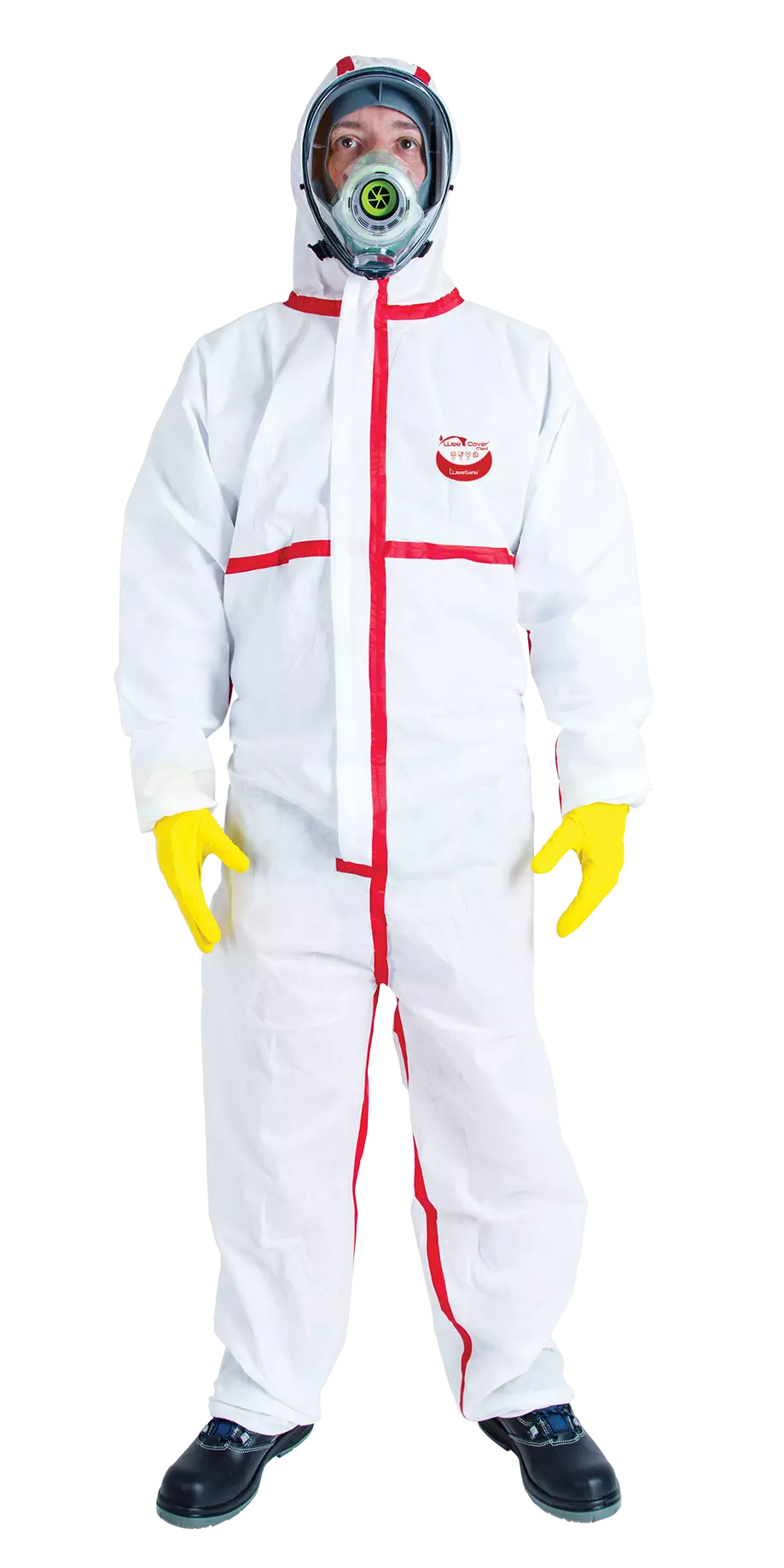WeeSafe WeeCover Max 1 Coverall Type 5/6, White/Red
Medicom
visit storeProduct description
A high-performance protective coverall designed specifically for asbestos-related work environments. This PPE Category III garment features thermosealed seams and ultra-breathable SMS material for optimal protection against hazardous particles while maintaining wearer comfort. Certified to meet Type 5/6 protection standards and EN 1073-2 requirements.
Product Features:
- Flat thermosealed seams for optimal protection against asbestos fibers
- Elastic waistband for enhanced fit
- Ultra-breathable SMS material construction
- Raglan sleeves for improved mobility
- Special asbestos packaging for PPE traceability
Technical Details:
- Protection Type 5 and 6 certification
- Thermobonded seam construction
- Loose fit design for air circulation
Standards:
- EU Regulation 2016/425 compliant
- PPE Category Cat. III
- CE certified
- EN 1073-2 compliant
The method used to fasten and secure the overalls, affecting ease of dressing, fit security, and convenience during work activities.
Defines the functional design type of the overalls, such as insulated for cold weather, disposable for contamination protection, or hooded for added coverage.
The fabric or combination of fabrics used to construct the overalls, affecting durability, protection level, comfort, and suitability for specific work environments.
Determines how the waist area fits and adjusts, affecting comfort and security of the coveralls during movement and work activities.
- Water Resistance
- Chemical Resistance
- Electrical Protection
Request a free sample
Test first and buy later. Visit any product page to request your free sample.
Standards and labels
EN 13034:2005 is a European standard that specifies the requirements and test methods for Type 6 protective clothing designed to provide protection against liquid chemicals. This standard sets criteria for the fabric's resistance to penetration by liquid chemicals and establishes guidelines for the overall design and construction of the clothing. It ensures that Type 6 protective clothing offers reliable protection for workers in industries where they may be exposed to liquid chemical hazards, but it may not be suitable for protection against airborne particles.
Test results
Liquid Chemical Protection Type 6EN 13034:2005 specifies the requirements and test methods for protective clothing that provides limited protection against liquid chemicals, designated as Type 6. The 'Type 6' classification indicates that the clothing has been tested and found capable of resisting light spray and minor splashes of liquid chemicals. This test method assesses the fabric's ability to prevent penetration from a synthetic blood solution sprayed at the garment at different angles and pressures, simulating realistic conditions where accidental chemical splashes might occur. Protective clothing that achieves this classification is essential for workers in industries such as chemical manufacturing, painting, or pesticide application, where there is a risk of exposure to harmful liquids but full immersion is not expected, thus enhancing worker safety by providing sufficient protection in low-volume chemical exposure scenarios.
EN 863:1995 is a European standard that sets out the requirements for stationary fire extinguishers. These are devices that can put out fires by extinguishing the flames, and are typically installed in a fixed location like a building or vehicle. The standard covers the performance requirements for fire fighting capability, mechanical strength, durability, safety and environmental factors of stationary fire extinguishers. To meet this standard, a stationary fire extinguisher must be able to effectively put out a fire, be able to withstand certain mechanical stress, be resistant to wear and tear, have safety features such as pressure relief devices and warning devices, be able to function in different environmental conditions, and have clear markings and instructions for use. Possible test results include measurements of the extinguisher's fire fighting capability, its mechanical strength, durability, safety features, environmental factors and user instructions.
EN ISO 13934-1:1999 is a standard for testing the strength of textile fabrics. It sets guidelines for measuring how much force a fabric can withstand before breaking. The fabric needs to meet certain requirements such as minimal elongation and minimal breaking strength. The test results will give a value in newtons or similar unit of force. It's used to evaluate the quality and durability of fabrics.
EN ISO 13935-2:1999 is a standard that defines the methods for testing the tear propagation resistance of textile fabrics. It includes requirements for testing equipment, sample preparation and test procedures. Test results should include the tear propagation resistance, measured in newton. The standard applies to all types of fabrics, and it is used to measure how well a fabric resists tearing or spreading of a tear once it has started.
EN ISO 7854:1997 is a standard for testing the flammability of automotive interior materials. It specifies the method for measuring the burning behavior of materials used in car interiors such as seats, dashboard, door panels, and headliners in a vertical position. The performance requirements include how quickly the material burns, how much it continues to burn after the flame is removed, and how much smoke is produced. Possible test results include a flame spread index, after flame index, smoke density, and toxic gas emissions. These test results are used to evaluate the flammability of the materials used in car interiors and to classify it according to the standard's criteria.
EN ISO 9073-4:2021 is a standard that sets rules for testing and measuring the performance of textile fabrics. It specifies the test methods and performance requirements for the resistance of textile fabrics to water penetration, which refers to how well the fabric repels water and prevents it from penetrating the fibers. The test results are measured in terms of the fabric's resistance to water penetration. The performance requirement is that the textile fabric must meet certain standards for resistance to water penetration, meaning it should repel water well and prevent it from penetrating the fibers.
EN 13688:2013 is a European standard that specifies the performance requirements for protective clothing. The standard includes requirements for safety, comfort, and durability, as well as tests for determining these properties. Protective clothing includes items like coveralls, aprons, and gloves that are worn to protect the wearer from hazards. Possible test results include resistance to chemicals, heat, abrasion and tearing, as well as breathability and comfort. The clothing can be tested under different conditions to check if it meets the standard's requirements.
EN 1073-2:2002 is a European standard that defines the requirements for measuring and evaluating the resistance of textiles to penetration of airborne radioactive particles. The standard includes procedures for measuring the ability of textile materials to prevent the penetration of radioactive particles through the fabric. The performance requirements specify the conditions for testing, as well as the evaluation criteria for determining resistance. Possible test results include a rating on a scale of 1-5, with 5 indicating the highest level of resistance to particle penetration.
CE Marking is a label that shows a product meets certain safety and environmental standards set by the European Union. To get the CE Marking, a company must test and certify their product meets these standards. CE Marking is required for many products sold in the EU, including electronics, machinery, toys and medical devices. It helps ensure that products are safe for consumers and the environment, and allows for easy trade within the EU.
PPE stands for "personal protective equipment." PPE Category 3 refers to equipment that is complex and provide the highest level of protection such as powered respirators, SCBA, and full body suits. In Europe, PPE Category 3 must meet certain safety standards set by the European Union, which means that it must be designed and manufactured to protect the user without causing harm. Companies that make or sell PPE must prove that it meets these standards. They also must have a quality management system in place, have to be audited regularly by a notified body and have to have a technical documentation.
Medicom delivery terms
Free delivery for all Medicom products
201,02 €
Price per 50 packages (50 pcs)
4,02 € / piece
Free delivery
A carton contains 50 packages (50 pieces)
Need larger quantities?
Other products you may like
Recently viewed
Need help?
Get help from our experts
Other products you may like
Similar products you may like
Autonomous sourcing platform
The most efficient way to source and order supplies for your operations
Sourcing
Ordering
List products you’re looking for and we’ll find the best products and prices for you – all for free.
Need help?
Get help from our experts



